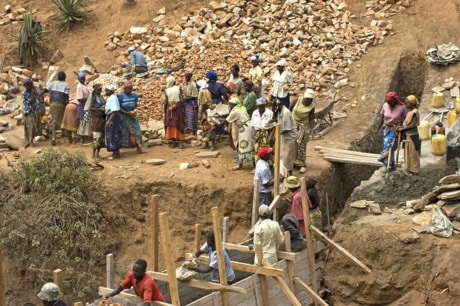When Joshua Mukusya was a child, he promised his mother he would provide the family with water – his duty as the first born.
But in his village of Kola in eastern Kenya, Mukusya had to walk eight kilometres to the closest water source and carry it back on his head – all in 45-degree heat.
Being a young boy, he would often start playing with friends on the journey home, and accidentally spill the water.
It always resulted in punishment from his mother.
So he worked on different ways of fulfilling his commitment.
Now, Mukusya is the CEO of Utooni Development Organization (UDO), a non-governmental organization that has constructed 1,440 sand dams in the Kenyan countryside.
The dams have provided safe and convenient water access to more than four million people.
Mukusya’s innovation has also spread to Somalia and Tanzania.
Those accomplishments are largely due to donations from organizations like the Mennonite Central Committee (MCC).
A partnership between the local MCC and UDO has been ongoing since 1978, in the form of funding and education.
Last week, the “grandfather and grandmother of sand dams in eastern Kenya,” were in Abbotsford for a few seminars, before heading to Kelowna, Alberta and Manitoba.
Phil Schafran, who dubbed Mukusya and his wife Rodah with the title, said it was a great experience for people to see and hear where their donations are going and who is being affected by them.
The presentations featured photos and first-hand stories, and explained how the money is divided between self-help groups in different villages.
The government-registered groups apply to UDO for a sand dam. Based on a number of variables, including how far the nearest water source is, UDO decides which groups to fund and assist.
Currently, there are 130 applications.
The dams cost $8,000 each to build, which covers the price of materials, material transfer and technical knowledge.
Last year, MCC funded 30 sand dams in eastern Kenya.
This year, it’s 35.
Once the dams are built, it takes approximately three years of sufficient rain for them to become fully functional.
Without rain, they are useless.
Once it becomes a mature structure, the dam can provide a village with water for seven to 10 years. Only six have failed in 33 years.
A successful dam affects the entire circle of life, said Mukusya. “Almost everything in these regions depend on water.”
They benefit local crops, animals and the health of villagers.
They also allow kids to go to school because they are no longer making long trips for water collection.
“When there’s no dam, the question is: how many kilometres will you go?,” said Mukusya.
Seventy per cent of those trips are made by women, often travelling over 20 kilometres to the nearest water source.
The water is carried in a jerry can attached to a rope across the woman’s head. The can lays on her back as she walks, often with a baby strapped to her front.
Sometimes the journey can take an entire day, or even two.
The closer the water source is, the more frequent the trip is made, said Mukusya, estimating four to five visits a week. Long trips are only done once or twice in a week.
In addition to the intense heat, there are many risks involved with such a long walk.
When the woman is gone, the children typically go without food.
Or the woman is raped.
If the mom is unable to go, she will send a child, who will miss school.
Building a sand dam in a village eliminates these long, dangerous treks.
“I feel satisfied when I see children going to school,” said Mukusya. “It inspires me to do more.”
And it’s also made his mother happy, he said.
“It was a promise to my mother. Now I can go to her and pump water to her house and say, ‘There, I’ve brought back the water.’ And that makes me happy.”
For more information on the projects check out www.mcc.org or www.utoonidevelopment.org.
